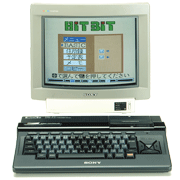In November 1986 Sony rolled out the HB-F1, a personal computer compatible with the MSX2 architecture standard and capable of displaying 80 characters per line and 256 simultaneous colors. The MSX2 standard offered backward compatibility with MSX software while enhancing MSX's functionality. Upgrades included the ability to display 16 colors from a 512-color palette, display 256 simultaneous colors, and support 512×212 pixel resolutions.
Priced at the same affordable prices of consumer-grade MSX models, the HB-F1 was developed to realize smooth scrolling, powerful graphics, and other functions that were fully compatible with the MSX2 architecture standard. It came with 128 kilobytes of RAM, the maximum under the MSX2 standard, and was preloaded with the HiT BiT Note software that could be used right out of the box. The HB-F1's hardware specifications were more than sufficient to run games as well.
The HB-F1 had the following features.
- 1.Priced on par with MSX models (\32,800), the HB-F1 was equipped with 128 kilobytes of video RAM, built-in MSX2-compatible software, multiple external interfaces, and hardware specifications that maximized MSX2 functionality. As a result, it could be used both for gaming and other personal uses and for running many different kinds of small businesses.
- 2.To add to the excitement of gaming, the HB-F1 came with a speed control lever that could adjust game speeds and the board switch that had been used on the HB-101 and other models.
- 3.HiT BiT Note, an MSX2-compatible software program, was built in. This version improved on past HiT BiT Note versions, which could process data for address books, memos, and schedules, and added clock, calculator, and calendar functions.
| Item | Descripition |
|---|---|
| CPU | Z80A equivalent |
| Memory | ROM: 48 KB (MSX-BASIC + built-in software) RAM: 64 KB (main); 128 KB (video) |
| Character and graphics resolutions | Screen 0: 40 characters×24 lines or 80 characters×24 lines, 2 colors from a 512-color palette Screen 1: 32 characters×24 lines, 16 colors from a 512-color palette Screen 2: 256×192 pixels, 16 colors from a 512-color palette Screen 3: 64×48 pixels, 16 colors from a 512-color palette Screen 4: 256×192 pixels, 16 colors from a 512-color palette Screen 5: 256×212 pixels, 16 colors from a 512-color palette, 4 pages Screen 6: 512×212 pixels, 4 colors from a 512-color palette, 4 pages Screen 7: 512×212 pixels, 16 colors from a 512-color palette, 2 pages Screen 8: 256×212 pixels, 256 colors, 2 pages |
| Sound functions | 8 octaves, three square wave generators, one sound effect generator |
| Cassette interface | 8-pin DIN connector, 1200/2400 baud |
| CRT interfaces | RF output, composite output, analog RGB output (8-pin DIN) |
| Keyboard | Full-stroke keyboard ASCII layout (for input of alphanumeric characters) or Japanese syllabary order (for input of hiragana and katakana characters), support for graphical symbols |
| Other external interfaces | Two MSX-standard cartridge slots (one was located on the back of the unit) Two joystick connectors Audio output Built-in calendar and clock |


